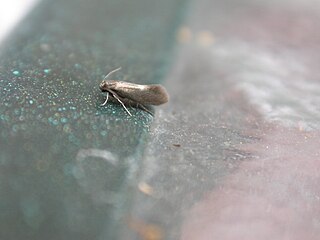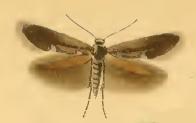
Lepidoptera is an order of insects that includes butterflies and moths. About 180,000 species of the Lepidoptera are described, in 126 families and 46 superfamilies, 10 percent of the total described species of living organisms. It is one of the most widespread and widely recognizable insect orders in the world. The Lepidoptera show many variations of the basic body structure that have evolved to gain advantages in lifestyle and distribution. Recent estimates suggest the order may have more species than earlier thought, and is among the four most species-rich orders, along with the Hymenoptera, Diptera, and Coleoptera.

A family of primitive monotrysian moths in the order Lepidoptera, Heliozelidae are small, metallic day-flying moths with shiny smooth heads. In Europe the small adult moths are seldom noticed as they fly quite early in the spring. The larvae are leaf miners and the vacated leaf mines are distinctive because the larva leaves a large hole at the end.

Heliozela resplendella is a moth of the Heliozelidae family. It is found from Fennoscandia and northern Russia to the Pyrenees, Alps and Romania and from Ireland to the Baltic region.

Heliozela hammoniella is a moth of the Heliozelidae family. It is found in Ireland, Great Britain, the Netherlands, France, Germany, Austria, the Czech Republic, Poland, Romania, Lithuania, Latvia, Fennoscandia, and Russia.

Heliozela sericiella is a moth of the Heliozelidae family found in Europe. The larvae mine the twigs of oaks, causing a gall.
Heliozela argyrozona is a moth of the family Heliozelidae. It was described in the genus Antispila by Edward Meyrick in 1918 and moved to the genus Heliozela by Erik J. van Nieukerken and Henk Geertsema in 2015. It is found in South Africa.

Heliozela is genus of moths of the family Heliozelidae. It was described by Gottlieb August Wilhelm Herrich-Schäffer in 1853.
Heliozela anantia is a moth of the Heliozelidae family. It was described by Edward Meyrick in 1897. It is found in Tasmania.
Heliozela autogenes is a moth of the Heliozelidae family. It was described by Edward Meyrick in 1897. It is found in Queensland.
Heliozela castaneella is a moth of the Heliozelidae family. It was described by Hiroshi Inoue in 1982. It is found in Japan.
Heliozela crypsimetalla is a moth of the Heliozelidae family. It was described by Edward Meyrick in 1897. It is found in South Australia.
Heliozela eucarpa is a moth of the Heliozelidae family. It was described by Edward Meyrick in 1897. It is found in New South Wales.
Heliozela gracilis is a moth of the Heliozelidae family. It was described by Zeller in 1873. It is found in North America, including Texas.
Heliozela isochroa is a moth of the Heliozelidae family. It was described by Edward Meyrick in 1897. It is found in New South Wales.
Heliozela microphylla is a moth of the Heliozelidae family. It was described by Edward Meyrick in 1897. It is found in Western Australia.
Heliozela siderias is a moth of the Heliozelidae family. It was described by Edward Meyrick in 1897. It is found in South Australia.
Heliozela sobrinella is a moth of the Heliozelidae family. It was described by Deventer in 1904 as almost identical to Heliozela praeustella but a bit larger, with a wingspan of 6 mm. It is found on Java.
Heliozela subpurpurea is a moth of the Heliozelidae family. It was described by Edward Meyrick in 1934. It is found in Japan.
Heliozela trisphaera is a moth of the Heliozelidae family. It was described by Edward Meyrick in 1897. It is found in New South Wales and South Australia.
Heliozela limbata is a moth of the family Heliozelidae. It was described by Lee, Hirowatari and Kuroko in 2006 and is endemic to Japan.




